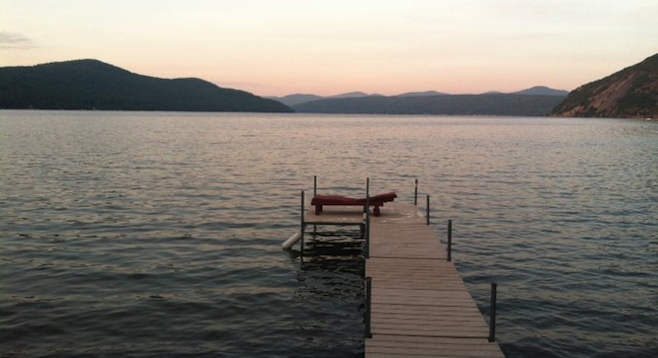 Facebook
Facebook
 X
X
 Instagram
Instagram
 TikTok
TikTok
 Youtube
Youtube

I opened my eyes and peeled my head from the pillow, waking to a lush wilderness of massive maples and juniper pines.
“The city” was a mere 220 miles away, but the silence and serenity made it feel much farther than that. Somewhere along our drive through upstate New York, as we snaked through the rolling Adirondack range, all reminders of the honking horns, droves of people and general mass of confusion of New York City's five boroughs had disappeared. With the beginning of summer came an explosion of greenness. I found myself engulfed by the trees – various types of ash, maple and birch – and a thick carpet undergrowth of ferns.
Looking out from the massive south end of Lake George, the deep blues of the water and light blue skies were interrupted only by rolling tree-lined hills. I'd reached a diamond in the rough, the "Queen of American Lakes."
Stretching more than 32 miles north and reaching up to three miles in width, it’s no wonder the Village of Lake George, located at the southern tip, is such a popular summer destination. The village boasts a number of restaurants, cafes, hotels and the famous Minne-Ha-Ha steamboat that takes visitors on a tour of the southern portion of the lake.
The one-hour journey costs about fifteen dollars, and takes you past beautiful homes and around a series of small islands that dot the spring-fed glacial lake. On a warm, sunny day, it doesn't get better than sitting back on the upper deck as the sounds of the chugging steamboat fill the air.
We ventured further north, past the “touristy” village another 30 miles or so to the town of Ticonderoga – or as locals call it, “Ti.” Nestled between Lake George to the south and Lake Champlain to the north, it's the quintessential small town; it seemed like everyone here knew each other. Locals I came across had stories to tell about their childhood growing up near the lake, as well as an eagerness to share knowledge about the history of this region that dates to the French and Indian War and beyond. Looking out on the still water as the sun began to rise, I couldn't help but imagine this place a few hundred years ago.
As morning approached, an otter poked his head above water, resurfacing just once before disappearing into the depths of the lake. A quick farewell to the night, or a greeting to the day. For me, it signaled the approaching end of my trip – one filled with long nights, early mornings, a couple joined and new friends found.
My experience here had stirred the wanderlust inside, urging me to keep exploring this beautiful part of the country.


I opened my eyes and peeled my head from the pillow, waking to a lush wilderness of massive maples and juniper pines.
“The city” was a mere 220 miles away, but the silence and serenity made it feel much farther than that. Somewhere along our drive through upstate New York, as we snaked through the rolling Adirondack range, all reminders of the honking horns, droves of people and general mass of confusion of New York City's five boroughs had disappeared. With the beginning of summer came an explosion of greenness. I found myself engulfed by the trees – various types of ash, maple and birch – and a thick carpet undergrowth of ferns.
Looking out from the massive south end of Lake George, the deep blues of the water and light blue skies were interrupted only by rolling tree-lined hills. I'd reached a diamond in the rough, the "Queen of American Lakes."
Stretching more than 32 miles north and reaching up to three miles in width, it’s no wonder the Village of Lake George, located at the southern tip, is such a popular summer destination. The village boasts a number of restaurants, cafes, hotels and the famous Minne-Ha-Ha steamboat that takes visitors on a tour of the southern portion of the lake.
The one-hour journey costs about fifteen dollars, and takes you past beautiful homes and around a series of small islands that dot the spring-fed glacial lake. On a warm, sunny day, it doesn't get better than sitting back on the upper deck as the sounds of the chugging steamboat fill the air.
We ventured further north, past the “touristy” village another 30 miles or so to the town of Ticonderoga – or as locals call it, “Ti.” Nestled between Lake George to the south and Lake Champlain to the north, it's the quintessential small town; it seemed like everyone here knew each other. Locals I came across had stories to tell about their childhood growing up near the lake, as well as an eagerness to share knowledge about the history of this region that dates to the French and Indian War and beyond. Looking out on the still water as the sun began to rise, I couldn't help but imagine this place a few hundred years ago.
As morning approached, an otter poked his head above water, resurfacing just once before disappearing into the depths of the lake. A quick farewell to the night, or a greeting to the day. For me, it signaled the approaching end of my trip – one filled with long nights, early mornings, a couple joined and new friends found.
My experience here had stirred the wanderlust inside, urging me to keep exploring this beautiful part of the country.
Comments